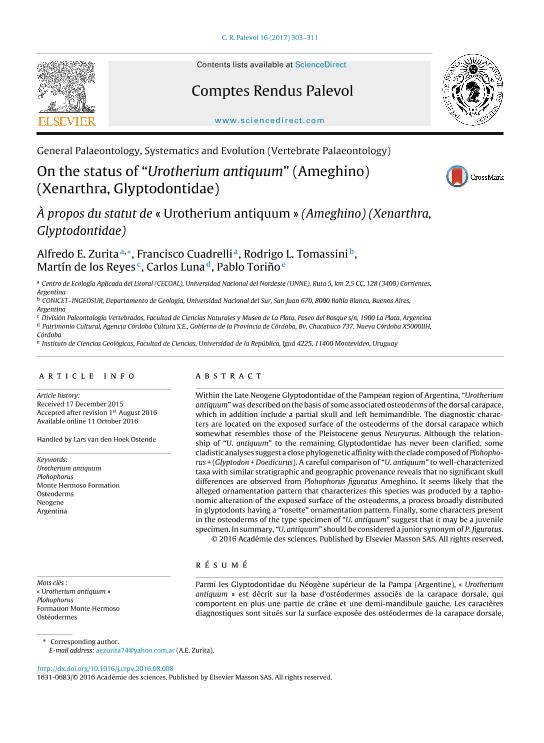Artículo
On the status of “Urotherium antiquum” (Ameghino) (Xenarthra, Glyptodontidae)
Título:
À propos du statut de « Urotherium antiquum » (Ameghino) (Xenarthra, Glyptodontidae)
Zurita, Alfredo Eduardo ; Cuadrelli, Francisco
; Cuadrelli, Francisco ; Tomassini, Rodrigo Leandro
; Tomassini, Rodrigo Leandro ; De Los Reyes, Martín; Luna, Carlos; Toriño, Pablo
; De Los Reyes, Martín; Luna, Carlos; Toriño, Pablo
 ; Cuadrelli, Francisco
; Cuadrelli, Francisco ; Tomassini, Rodrigo Leandro
; Tomassini, Rodrigo Leandro ; De Los Reyes, Martín; Luna, Carlos; Toriño, Pablo
; De Los Reyes, Martín; Luna, Carlos; Toriño, Pablo
Fecha de publicación:
04/2017
Editorial:
Elsevier Masson
Revista:
Comptes Rendus Palevol
ISSN:
1631-0683
Idioma:
Inglés
Tipo de recurso:
Artículo publicado
Clasificación temática:
Resumen
Within the Late Neogene Glyptodontidae of the Pampean region of Argentina, “Urotherium antiquum” was described on the basis of some associated osteoderms of the dorsal carapace, which in addition include a partial skull and left hemimandible. The diagnostic characters are located on the exposed surface of the osteoderms of the dorsal carapace which somewhat resembles those of the Pleistocene genus Neuryurus. Although the relationship of “U. antiquum” to the remaining Glyptodontidae has never been clarified, some cladistic analyses suggest a close phylogenetic affinity with the clade composed of Plohophorus + (Glyptodon + Doedicurus). A careful comparison of “U. antiquum” to well-characterized taxa with similar stratigraphic and geographic provenance reveals that no significant skull differences are observed from Plohophorus figuratus Ameghino. It seems likely that the alleged ornamentation pattern that characterizes this species was produced by a taphonomic alteration of the exposed surface of the osteoderms, a process broadly distributed in glyptodonts having a “rosette” ornamentation pattern. Finally, some characters present in the osteoderms of the type specimen of “U. antiquum” suggest that it may be a juvenile specimen. In summary, “U. antiquum” should be considered a junior synonym of P. figuratus.
Archivos asociados
Licencia
Identificadores
Colecciones
Articulos(CECOAL)
Articulos de CENTRO DE ECOLOGIA APLICADA DEL LITORAL (I)
Articulos de CENTRO DE ECOLOGIA APLICADA DEL LITORAL (I)
Articulos(INGEOSUR)
Articulos de INST.GEOLOGICO DEL SUR
Articulos de INST.GEOLOGICO DEL SUR
Citación
Zurita, Alfredo Eduardo; Cuadrelli, Francisco; Tomassini, Rodrigo Leandro; De Los Reyes, Martín; Luna, Carlos; et al.; On the status of “Urotherium antiquum” (Ameghino) (Xenarthra, Glyptodontidae); Elsevier Masson; Comptes Rendus Palevol; 16; 3; 4-2017; 303-311
Compartir
Altmétricas



